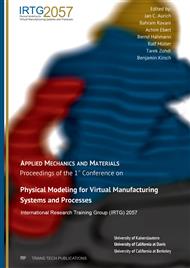[1]
T. Bauernhansl, Die Vierte Industrielle Revolution - Der Weg in ein wertschaffendes Produktionsparadigma, in: T. Bauernhansl, M. Hompel, B. Vogel-Heuser (Eds. ), Industrie 4. 0 in Produktion, Automatisierung und Logistik, Springer-Verlag, Wiesbaden, 2014, pp.5-34.
DOI: 10.1007/978-3-658-04682-8_1
Google Scholar
[2]
H. Bullinger, Geleitwort, H. Bullinger, D. Spath, H. Warnecke, E. Westkämper (Eds. ), in: Handbuch Unternehmensorganisation - Strategie, Planung, Umsetzung, Springer-Verlag, Berlin Heidelberg, 2009, pp. v-x.
DOI: 10.1007/978-3-540-87595-6
Google Scholar
[3]
H. Jodlbauer, Produktionsoptimierung - Wertschaffende sowie kundenorientierte Planung und Steuerung, Springer-Verlag, Wien, (2007).
Google Scholar
[4]
J. Kletti, J. Schumacher, Die perfekte Produktion - Manufacturing Excellence durch Short Interval Technology (SIT), Springer-Verlag, Berlin Heidelberg, (2011).
DOI: 10.1007/978-3-642-13845-4_4
Google Scholar
[5]
J. Kletti, Die Anforderungen an die moderne Produktion, in: J. Kletti (Eds. ), MES Manufacturing Execution System - Moderne Informationstechnologie unterstützt die Wertschöpfung, second ed., Springer-Verlag, Berlin Heidelberg, 2015, pp.1-18.
DOI: 10.1007/978-3-662-46902-6_1
Google Scholar
[6]
K. Erlach, Wertstromdesign - Der Weg zur schlanken Fabrik, second ed., Springer-Verlag, Berlin Heidelberg, (2010).
DOI: 10.1007/978-3-540-89867-2
Google Scholar
[7]
E. Westkämper, E. Zahn, Einführung, in: E. Westkämper, E. Zahn (Eds. ), Wandlungsfähige Produktionsunternehmen - Das Stuttgarter Unternehmensmodell, Springer-Verlag, Berlin Heidelberg, 2009, pp.1-5.
DOI: 10.1007/978-3-540-68890-7
Google Scholar
[8]
E. Westkämper, C. Löffler, Strategien der Produktion - Technologien, Konzepte und Wege in die Praxis, Springer-Verlag, Berlin Heidelberg, (2016).
DOI: 10.1007/978-3-662-48914-7
Google Scholar
[9]
E. Abele, S. Bechtloff, J. Schumacher, Den Kundenwunsch erfüllen - Erhöhung der Termintreue durch individuell abgestimmten IT-Einsatz: submitted to Werkstatt + Betrieb (2009).
Google Scholar
[10]
D. Berkholz, Wandlungsfähige Produktionssysteme - der Zukunft einen Schritt voraus, in: P. Nyhuis, G. Reinhart, E. Abele (Eds. ), Wandlungsfähige Produktionssysteme - Heute die Industrie von morgen gestalten, Verlag PZH, Hannover, 2008, pp.13-18.
DOI: 10.3139/104.101285
Google Scholar
[11]
R. D. Schraft, R. Kaun, Automatisierung der Produktion - Erfolgsfaktoren und Vorgehen in der Praxis, Springer-Verlag, Berlin Heidelberg, (1998).
DOI: 10.1007/978-3-662-05950-0_2
Google Scholar
[12]
A. Kumpf, Anforderungsgerechte Modellierung von Materialflusssystemen zur planungsbegleitenden Simulation, Herbert Utz Verlag GmbH, München, (2001).
Google Scholar
[13]
F. Abolhassan, Einleitung, in: F. Abolhassan, J. Kellermann (Eds. ), Effizienz durch Automatisierung - Das Zero Touch, -Prinzip im IT-Betrieb, Springer-Verlag, Wiesbaden, 2016, pp.9-13.
DOI: 10.1007/978-3-658-10644-7
Google Scholar
[14]
A. Botthof, Zukunft der Arbeit im Kontext von Autonomik und Industrie 4. 0, in: A. Botthof, E. A. Hartmann (Eds. ), Zukunft der Arbeit in Industrie 4. 0, Springer-Verlag, Berlin Heidelberg, 2015, pp.3-8.
DOI: 10.1007/978-3-662-45915-7_1
Google Scholar
[15]
W. Eversheim, Organisation in der Produktionstechnik - Arbeitsvorbereitung, third ed., Springer-Verlag, Berlin Heidelberg, (2012).
Google Scholar
[16]
G. Kasakow, N. Menck, J.C. Aurich, Event-driven production planning and control based on individual customer orders, 49th CIRP Conference on manufacturing Systems (2016) 434-438.
DOI: 10.1016/j.procir.2016.11.075
Google Scholar


